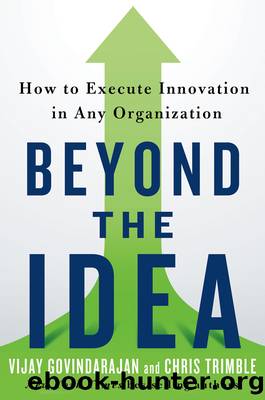Beyond the Idea by Vijay Govindarajan

Author:Vijay Govindarajan
Language: eng
Format: epub
Publisher: St. Martin's Publishing Group
MISTAKE #1: TOO MANY INSIDERS
It is generally easier, faster, and more comfortable to move insiders onto the Dedicated Team than it is to recruit outsiders with new skills. Doing the latter can be cumbersome. It can require working with new search firms or relying on personal networks rather than the companyâs established recruiting channels.
That said, too great a fraction of insiders on the Dedicated Team can be problematic. The most direct issue that it can create is a skills shortfall. If, for example, a manufacturing company desires to expand the value it offers its customers by launching new services, it probably makes sense to hire a few people from those specific service industries. This logic is straightforward, but the pressures to move quickly are high, and the tendency to overestimate the skills of the people you already have is commonplace.
Dedicated Teams that are dominated by insiders are also far more likely to act like Little Performance Engines. Part of the reason is that insiders tend to share, and mutually reinforce, a common set of assumptions about what leads to business success. These are, of course, the factors that are believed to have been important in driving the Performance Engineâs past successesâand they may or may not have anything to do with what matters for the innovation initiative.
Even more perniciously, Dedicated Teams composed entirely of insiders, especially those who know each other and have worked together in the past, typically struggle to adapt to a new organizational model. Consider two people who have worked closely for a long time within the Performance Engine. Despite the new demands of the innovation initiative, their work relationship is likely to persist on the Dedicated Teamâthe same assumptions about who does what work, who is in charge, what information is shared, and so forth. Work relationships are sticky.
We argued in the last chapter that changing a work relationship within the Shared Staff is next to impossible. It is, thanks to the relentless pressures of day-to-day operations, which constantly reinforce the existing relationship. Redefining work relationships is far more feasible within the Dedicated Team, but it remains hard. It still requires a very explicit and conscious effort on the part of both parties to reconsider and renegotiate the relationship with the innovation initiative in mind. (It may help to think about your spouse. How easy is it to renegotiate this long-standing work relationshipâwho does what, who makes which decisions, and so on?)
The larger the Dedicated Team, the greater the effort required to overcome the inertia of past work relationships. Every relationship has to be renegotiated. Each one that is not renegotiated is like an anchor dragging the team toward a not-so-desirable status as a Little Performance Engine.
The solution? Outsiders. They naturally counter each of the three problems described above. They bring new skills. They naturally challenge assumptions, simply because they have experienced a different history of success and failure. Most critical, however, is that outsiders are natural catalysts in breaking down existing work relationships and building new ones from scratch.
Download
This site does not store any files on its server. We only index and link to content provided by other sites. Please contact the content providers to delete copyright contents if any and email us, we'll remove relevant links or contents immediately.
| Ethics | Etiquette |
| Fashion & Image | Health & Stress |
| Motivation & Self-Improvement | Work Life Balance |
| Workplace Culture |
Tools of Titans by Timothy Ferriss(8181)
Change Your Questions, Change Your Life by Marilee Adams(7607)
Deep Work by Cal Newport(6849)
Man-made Catastrophes and Risk Information Concealment by Dmitry Chernov & Didier Sornette(5897)
Playing to Win_ How Strategy Really Works by A.G. Lafley & Roger L. Martin(5848)
Digital Minimalism by Cal Newport;(5629)
Big Magic: Creative Living Beyond Fear by Elizabeth Gilbert(5575)
The Slight Edge by Jeff Olson(5332)
Ego Is the Enemy by Ryan Holiday(5263)
The Motivation Myth by Jeff Haden(5140)
Stone's Rules by Roger Stone(5010)
The Laws of Human Nature by Robert Greene(4964)
Tuesdays with Morrie by Mitch Albom(4657)
Eat That Frog! by Brian Tracy(4407)
Rising Strong by Brene Brown(4359)
Skin in the Game by Nassim Nicholas Taleb(4141)
Bullshit Jobs by David Graeber(4056)
The Money Culture by Michael Lewis(4049)
Skin in the Game: Hidden Asymmetries in Daily Life by Nassim Nicholas Taleb(3903)
